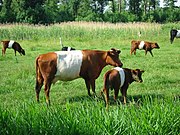Lakenvelder cattle

Dutch Belted cow
|
|
| Conservation status | critical |
|---|---|
| Nicknames | Lakenvelder |
| Country of origin | Netherlands |
| Use | Dairy |
| Traits | |
| Weight |
|
|
|
Lakenvelders near Leusden
Current races are more productive, but there are small scale initiatives to preserve the race.
Some Dutch belted cows produce over 9000 liters of milk per lactation.[1]
There is also a rare breed of domestic poultry called Lakenvelder that has this same belted colouring with a solid black neck hackle and black tail but with a pure white body.
Contents
Breed Characteristics
The Dutch Belted cow is primarily a dairy breed. Average size ranges from 410 to 680 kg (900 to 1,500 lb), with bulls weighing as much as 910 kg (2,000 lb). Cattle have a base color of either black (most common) or a dusky red, and the breed’s most distinguishing characteristic is the wide "belt" of white around its middle, placed between the shoulders and the hips.[1] The breed is not naturally polled.[2]As a dairy breed, Dutch Belts produce with greater efficiency on grass and forage than the average breed, and intensive management practices are not required. Cows can produce 9,100 kg (20,000 lb) of milk per year.[1][3] Fat globules in the milk are naturally very small, rendering the milk partially homogenized and easily digested. Butterfat content ranges from 3.5-5.5%.[1]
The breed’s fertility / reproductive efficiency is claimed to exceed that of the Holstein. Calving difficulties are not common.[1] Because of the stockier frame of the breed, crossbreeding will produce a higher beef yield than through the average dairy cow, rendering the Dutch Belted a viable all-purpose breed.[3][1]
History
The original belted cattle originated in Austria and Switzerland. By the 17th century, these ancestors of the Dutch Belted breed were moved to the Netherlands by Dutch nobility.[4][1] The “belted” color pattern was highly desirable in the Netherlands, and the nobility who owned these cows are also claimed to have bred the belted color pattern into other livestock, including Hampshire pigs, Dutch rabbits, and Lakenvelder chickens.[1][5]Dutch Belted cows were imported into the USA in the 1830s, where they were exhibited as a rare breed by P.T. Barnum in his travelling circus.[6][1] The 1886, the Dutch Belted Cattle Association of America herdbook was established, and still continues today as the oldest continual registry for the breed worldwide.[1]
The breed became well established in the USA and continued in popularity until about 1940,[4] but during the 1900s, numbers of Dutch Belted cattle declined worldwide to the point of near-extinction.[6] In the USA, the breed’s decline in popularity was exacerbated by a government herd reduction / buy-out program, which encouraged selling dairy cattle for beef to bolster milk prices.[6]
Preservation Efforts
The American Livestock Breeds Conservancy lists the Dutch Belted as "critical" on the Conservation Priority list.[7] The population in the USA is estimated at less than 300,[2] with fewer than 1,000 worldwide.[6] Cross-breeding in the Netherlands has resulted in dilution of original stock, and the US population of Dutch Belted cattle is now considered purer and more true to the original genotype than are the cows in the Netherlands today.[4][3]Currently, a "Breeding Up" program designed to increase numbers and genetic diversity of the Dutch Belted is in place. The program breeds registered Dutch Belted bulls with grade cows. By the fifth generation, offspring are considered 96.88% pure and eligible for full registration with the DBCAA.[8]








No comments:
Post a Comment